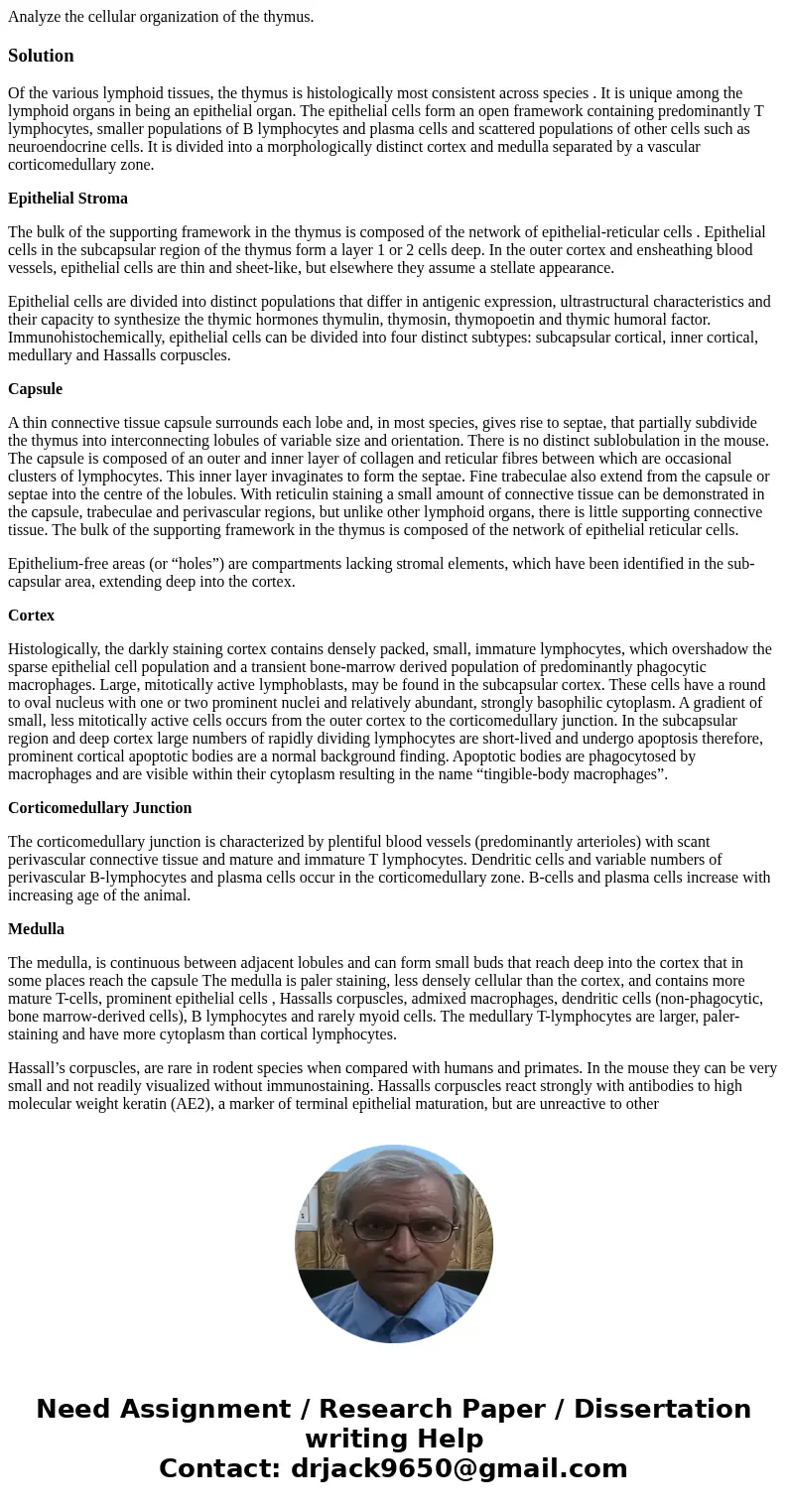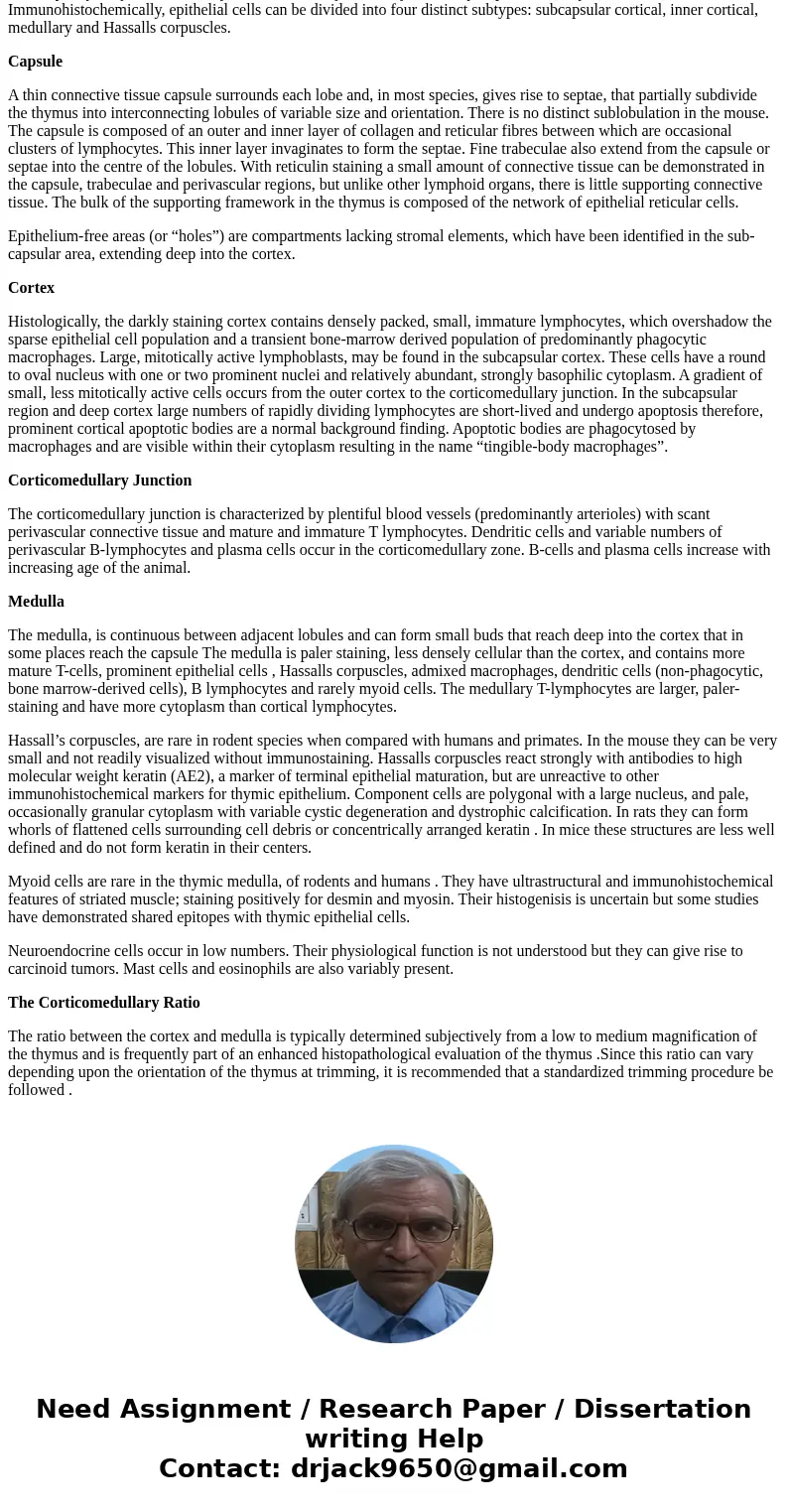Analyze the cellular organization of the thymusSolutionOf th
Analyze the cellular organization of the thymus.
Solution
Of the various lymphoid tissues, the thymus is histologically most consistent across species . It is unique among the lymphoid organs in being an epithelial organ. The epithelial cells form an open framework containing predominantly T lymphocytes, smaller populations of B lymphocytes and plasma cells and scattered populations of other cells such as neuroendocrine cells. It is divided into a morphologically distinct cortex and medulla separated by a vascular corticomedullary zone.
Epithelial Stroma
The bulk of the supporting framework in the thymus is composed of the network of epithelial-reticular cells . Epithelial cells in the subcapsular region of the thymus form a layer 1 or 2 cells deep. In the outer cortex and ensheathing blood vessels, epithelial cells are thin and sheet-like, but elsewhere they assume a stellate appearance.
Epithelial cells are divided into distinct populations that differ in antigenic expression, ultrastructural characteristics and their capacity to synthesize the thymic hormones thymulin, thymosin, thymopoetin and thymic humoral factor. Immunohistochemically, epithelial cells can be divided into four distinct subtypes: subcapsular cortical, inner cortical, medullary and Hassalls corpuscles.
Capsule
A thin connective tissue capsule surrounds each lobe and, in most species, gives rise to septae, that partially subdivide the thymus into interconnecting lobules of variable size and orientation. There is no distinct sublobulation in the mouse. The capsule is composed of an outer and inner layer of collagen and reticular fibres between which are occasional clusters of lymphocytes. This inner layer invaginates to form the septae. Fine trabeculae also extend from the capsule or septae into the centre of the lobules. With reticulin staining a small amount of connective tissue can be demonstrated in the capsule, trabeculae and perivascular regions, but unlike other lymphoid organs, there is little supporting connective tissue. The bulk of the supporting framework in the thymus is composed of the network of epithelial reticular cells.
Epithelium-free areas (or “holes”) are compartments lacking stromal elements, which have been identified in the sub-capsular area, extending deep into the cortex.
Cortex
Histologically, the darkly staining cortex contains densely packed, small, immature lymphocytes, which overshadow the sparse epithelial cell population and a transient bone-marrow derived population of predominantly phagocytic macrophages. Large, mitotically active lymphoblasts, may be found in the subcapsular cortex. These cells have a round to oval nucleus with one or two prominent nuclei and relatively abundant, strongly basophilic cytoplasm. A gradient of small, less mitotically active cells occurs from the outer cortex to the corticomedullary junction. In the subcapsular region and deep cortex large numbers of rapidly dividing lymphocytes are short-lived and undergo apoptosis therefore, prominent cortical apoptotic bodies are a normal background finding. Apoptotic bodies are phagocytosed by macrophages and are visible within their cytoplasm resulting in the name “tingible-body macrophages”.
Corticomedullary Junction
The corticomedullary junction is characterized by plentiful blood vessels (predominantly arterioles) with scant perivascular connective tissue and mature and immature T lymphocytes. Dendritic cells and variable numbers of perivascular B-lymphocytes and plasma cells occur in the corticomedullary zone. B-cells and plasma cells increase with increasing age of the animal.
Medulla
The medulla, is continuous between adjacent lobules and can form small buds that reach deep into the cortex that in some places reach the capsule The medulla is paler staining, less densely cellular than the cortex, and contains more mature T-cells, prominent epithelial cells , Hassalls corpuscles, admixed macrophages, dendritic cells (non-phagocytic, bone marrow-derived cells), B lymphocytes and rarely myoid cells. The medullary T-lymphocytes are larger, paler-staining and have more cytoplasm than cortical lymphocytes.
Hassall’s corpuscles, are rare in rodent species when compared with humans and primates. In the mouse they can be very small and not readily visualized without immunostaining. Hassalls corpuscles react strongly with antibodies to high molecular weight keratin (AE2), a marker of terminal epithelial maturation, but are unreactive to other immunohistochemical markers for thymic epithelium. Component cells are polygonal with a large nucleus, and pale, occasionally granular cytoplasm with variable cystic degeneration and dystrophic calcification. In rats they can form whorls of flattened cells surrounding cell debris or concentrically arranged keratin . In mice these structures are less well defined and do not form keratin in their centers.
Myoid cells are rare in the thymic medulla, of rodents and humans . They have ultrastructural and immunohistochemical features of striated muscle; staining positively for desmin and myosin. Their histogenisis is uncertain but some studies have demonstrated shared epitopes with thymic epithelial cells.
Neuroendocrine cells occur in low numbers. Their physiological function is not understood but they can give rise to carcinoid tumors. Mast cells and eosinophils are also variably present.
The Corticomedullary Ratio
The ratio between the cortex and medulla is typically determined subjectively from a low to medium magnification of the thymus and is frequently part of an enhanced histopathological evaluation of the thymus .Since this ratio can vary depending upon the orientation of the thymus at trimming, it is recommended that a standardized trimming procedure be followed .


 Homework Sourse
Homework Sourse